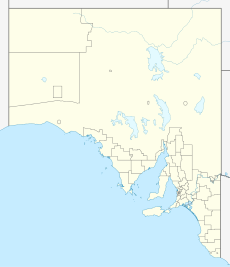Hundred of Kapunda
|
Kapunda South Australia |
|||||||||||||||
|---|---|---|---|---|---|---|---|---|---|---|---|---|---|---|---|

Looking towards the Baptist church
|
|||||||||||||||
| Coordinates | 34°20′20″S 138°55′00″E / 34.33889°S 138.91667°ECoordinates: 34°20′20″S 138°55′00″E / 34.33889°S 138.91667°E | ||||||||||||||
| Population | 2,917 (2016 census) | ||||||||||||||
| Established | 1839 | ||||||||||||||
| Postcode(s) | 5373 | ||||||||||||||
| Elevation | 245 m (804 ft) | ||||||||||||||
| Location | 77 km (48 mi) north of Adelaide | ||||||||||||||
| LGA(s) | Light Regional Council | ||||||||||||||
| State electorate(s) | Stuart | ||||||||||||||
| Federal Division(s) | Wakefield | ||||||||||||||
|
|||||||||||||||
|
|||||||||||||||
Kapunda is a town on the Light River and near the Barossa Valley in South Australia. It was established after a discovery in 1842 of significant copper deposits.
The southern entrance to the town has been dominated since 1988 by the 8-metre-tall statue of Map Kernow ("the son of Cornwall"), a traditional Cornish miner. The statue was destroyed by a fire on the morning of 1 June 2006 but has since been rebuilt by its creator, Ben van Zetten.
Francis Dutton and Charles Bagot, who both ran sheep in the area, discovered copper ore outcrops in 1842. They purchased 80 acres (32 ha) around the outcrop, beginning mining early in 1844 after good assay results. Mining began with the removal of surface ore and had progressed to underground mining by the end of the year. Copper was mined until 1879. There are also quarries near the town which provide fine marble ranging from dark blue to white. Marble from the Kapunda quarries was used to face Parliament House in Adelaide, and the pedestal of the statue of Venus on North Terrace, Adelaide is made of Sicilian and Kapunda marble.
Ore was initially exported to Swansea, Wales, but later Welsh smelters migrated to South Australia and the ore was smelted locally by 1851. Typically, the miners were Cornish, labourers were Irish and smelter specialists were Welsh. Trade and agriculture were Scottish and English. German farmers and timber cutters at nearby Bethel had already been in the area. Underground mining became more difficult as the mines reached deeper. A steam engine to drive a water pump was installed in 1847, replaced by a larger one in 1851. In 1865, the mine was leased to a Scottish company which switched to open cut mining methods and replaced the smelters with a different treatment method (cooking the ore with salt to produce copper chloride). Copper prices fell in 1877 and the mine closed in 1879. Mining operations ground to a halt in 1851 with the impact of the Victorian gold rush, restarted in 1855.
...
Wikipedia

